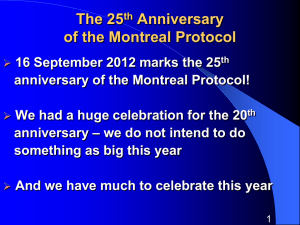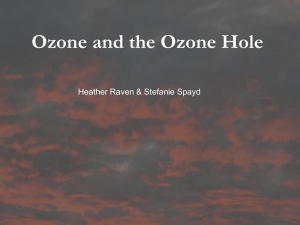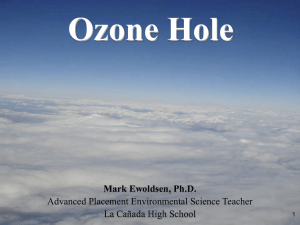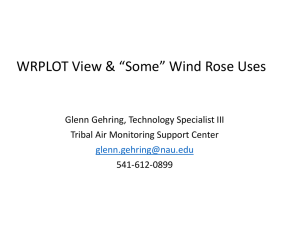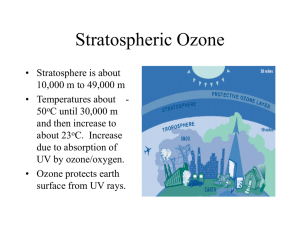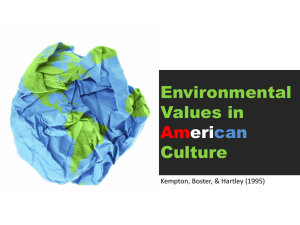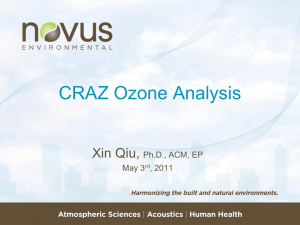0910_Kurylo_Newman_ORM_SAP_v2
advertisement
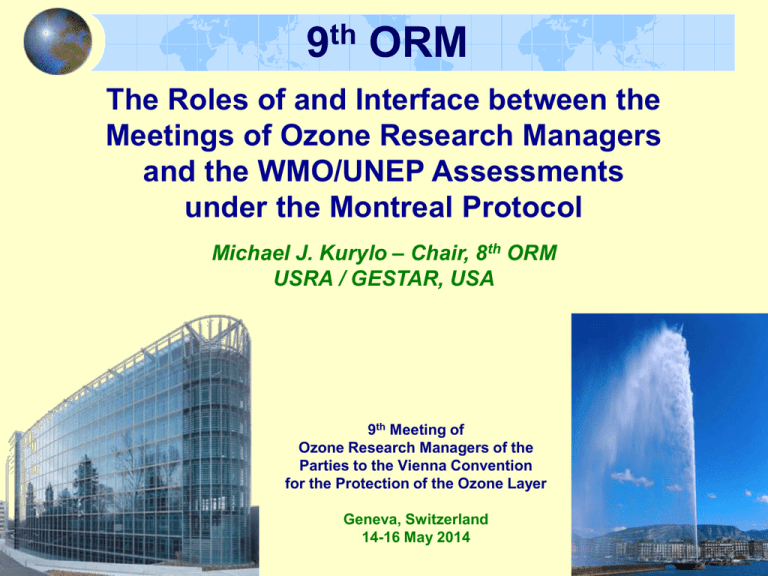
9th ORM The Roles of and Interface between the Meetings of Ozone Research Managers and the WMO/UNEP Assessments under the Montreal Protocol Michael J. Kurylo – Chair, 8th ORM USRA / GESTAR, USA 9th Meeting of Ozone Research Managers of the Parties to the Vienna Convention for the Protection of the Ozone Layer Geneva, Switzerland 14-16 May 2014 9th ORM Background • A meeting of Ozone Research Managers of the Parties to the Vienna Convention for the Protection of the Ozone Layer is required every three years (6 months prior to the Meeting of the Parties). • Each ORM meeting will review ongoing research and monitoring programs for ozone and UV-B to – Assess research (including measurement calibration and archiving) related to the health and environmental effects of ozone modifications – Identify research and monitoring gaps – Ensure national and international coordination – Develop a set of recommendations for future research and expanded cooperation in developed and developing countries 9th ORM • The ORMs and the 3 WMO-UNEP Assessments (Scientific, Environmental Effects, Technology and Economic) have very different, yet highly complementary, roles. - The ORM is required under the Vienna Convention and its Montreal Protocol. - The Assessments are mandated under the Montreal Protocol - They all serve as communication devices between the research community (striving for better understanding) and decision makers (for informed action). - The Assessment Panel Summaries and the ORM Recommendations are all presented at the subsequent joint meetings of the Conference of the Parties to the Vienna Convention and the Meeting of the Parties to the Montreal Protocol. 9th ORM Within the context of the request of the Parties, there are: • Aspects Unique to the Assessments: – They enable the Parties to evaluate control measurements under the Montreal Protocol. – They constitute neither policy recommendations nor research planning documents but provide input for both. • Aspects Unique to the ORMs: – The ORM Reports specifically address research and monitoring needs in light of scientific understanding provided by the Assessments. – The ORM Reports make specific recommendations to the Parties regarding international funding for improved research coordination and networking. 9th ORM Implementation: • Agenda Items for 9th ORM Meeting – – – – – – Review of 8th ORM Recommendations State of the Ozone Layer presentations including climate links Updates on international monitoring programs Satellite research and monitoring programs (present and future) Regional reports on ozone research and monitoring taking into account the available national reports Recommendations (Research Needs, Systematic Observations, Capacity Building, Data Archiving) The 2014 Ozone Assessment: Addressing the Needs of the Parties 9th Meeting WMO/UNEP Ozone Research Managers of the Parties to the Vienna Convention for the Protection of the Ozone Layer Geneva, Switzerland 14 May 2014 SAP Co-chairs Ayité-Lô Ajavon (Togo) Paul Newman (USA) John Pyle (UK) A.R. Ravishankara (USA) What is the Scientific Assessment Panel? MP Article 6: Assessment and review of control measures Beginning in 1990, and at least every four years thereafter, the Parties shall assess the control measures provided for in Article 2 and Articles 2A to 2I on the basis of available scientific, environmental, technical and economic information. UNEP initiated the assessment panel process in 1988 pursuant to this article. What is the Scientific Assessment? What the assessments are: • “One-stop shopping” for the Parties: – – – – • State of science: What we know & what we don’t, framed in policy-useful terms. – – • Science of the ozone layer (Scientific Assessment Panel) Impacts of ozone change (Environmental Effects Panel). Technology/economics of options (Technology and Economic Assessment Panel) Synthesis report by all three panels Scientific documents, prepared & reviewed by the expert communities. Assessed viewpoints, not reviews. Customers include scientists, Governments, Industry, and the Public What the assessments are not: • • They don’t make policy recommendations, but they may include analysis of policy options. They are not research-planning documents, nor do they “push” research projects or needs. (They do identify gaps in information that may limit informed decision-making). - However, based on the findings and gaps, you can see what is needed! What did the Parties to the Montreal Protocol ask for in the 2014 assessment? • Terms of reference from the Parties to the Protocol decided at the 23rd meeting of the Parties in Montreal, Bali, Indonesia, 21-25 November 2011. Specific request included: • A general update of science since the 2010 Assessment • Key ongoing issues – Levels of ODS and trends – Levels of ozone and its trends – Our understanding of the ozone layer science • What emerging science – The impact of climate change on ozone layer recovery – The impact of ozone layer changes on climate and its changes • Key additional requests from the Parties to the Protocol The Parties’ Request (Decision XXIII/13) “Terms of Reference” for the 2014 SAP Report a. Assessment of the state of the ozone layer and its future evolution, including in respect of atmospheric changes from, for example, sudden stratospheric warming or accelerated Brewer-Dobson circulation; b. Evaluation of the Antarctic ozone hole and Arctic winter/spring ozone depletion and the predicted changes in these phenomena, with a particular focus on temperatures in the polar stratosphere; c. Evaluation of trends in the concentration in the atmosphere of ozone-depleting substances and their consistency with reported production and consumption of those substances and the likely implications for the state of the ozone layer and the atmosphere; d. Assessment of the interaction between the ozone layer and the atmosphere; including: i. The effect of polar ozone depletion on tropospheric climate; ii. The effects of atmosphere-ocean coupling; e. Description and interpretation of observed ozone changes and ultraviolet radiation, along with future projections and scenarios for those variables, taking into account among other things the expected impacts to the atmosphere; f. Assessment of the effects of ozone-depleting substances and other ozone-relevant substances, if any, with stratospheric influences, and their degradation products, the identification of such substances, their ozone-depletion potential and other properties; g. Identification of any other threats to the ozone layer… 4/8/14 2014 O3 assmt., 2nd draft review, Boulder CO 10 Timeline Discussion Paper circulated for comments by scientific community (Feb.) 2013 Lead Authors and Chapter Editors established (early Apr) Chapter author teams assembled, early preparation steps begin (early May) Draft of Chapter outlines (late May) 1st meeting of Lead Authors, Cochairs, Steering Committee, Chapter Editors (Jun) Individual Chapter team meetings (convened by Lead Authors (Jul-Sep) Chapter summary bullets and outlines submitted for review (October 1, 2013) 1st drafts of Chapters completed (30 October, 2013) Mail Review of Chapter 1st drafts begins (1 Nov) Chapter 1st drafts reviews due (15 Dec.) 2014 Chapter editor summaries sent to Lead Authors (early Jan.) 2nd draft of Chapters completed (Mar 12, 2014) Review and completion of 2nd (final) draft Drafting of Assessment for Decision-Makers begins Final drafts of Chapters completed (all cited papers in press) mid-May Draft Assessment for Decision-Makers distributed to Panel Reviewers (early Jun) Panel Rev. Meeting [discuss/finalize Assessment for Decision-Makers] (JunLes 23-27) Diablerets 4/8/14 2014 O3 assmt., 2nd draft review, Boulder CO 11 Ground Observations of ODSs • HCFC-22 & Halon1301 continues to increase • CCl4 discrepancy with emissions • Discovery of new CFCs • See Dr. Ravishankara’s talk on HFCs High quality measurements of ODSs, GHGs, and related gases are crucial for supporting the MP Total Ozone • Total ozone shows that there may be increases since 2013. Attribution? High quality measurements of total ozone are crucial to detecting recovery Ozone profiles are showing evidence of recovery in the upper stratosphere High quality measurements of ozone profiles are crucial to detecting recovery in the upper stratosphere • Ozone time series at 42 km altitude averaged in NH mid-latitude (3560N). • Ozone shows a strong decline into late 1990s • Some evidence that ozone is “above” the 1998-2008 average in the last few years Is the ozone hole recovering? Why is the NH showing large ozone depletions? SH ozone seems to be trending upward. Recovery? Interpreting polar ozone requires observations of total ozone, ozone profiles, and ancillary observations (e.g., winds, T, ClO, HCl) Stratospheric Temperatures • Stratospheric temperatures have cooled since the late 1970s • Largest changes are the in upper stratosphere • There are serious disagreements between differing satellite radiance processing Cooling of the stratosphere is caused by increasing GHGs. Global observations of stratospheric observations are needed, plus ground observations of the upper stratosphere for calibration and validation SH response to O3 hole • Data and models suggest that a number of processes in SH summer are sensitive to long-term change in the SAM. • How is the circulation response to O3 hole communicated downward? • Continued observations are critical to understanding climate in the SH as ozone rebounds. Do we have the necessary observations for diagnosing the meteorological changes in the SH as the ozone hole begins to recover? Thompson et al. (2011) Is the Brewer-Dobson circulation accelerating? Observations of long-lived species (e.g., SF6 and CO2 for age, H2O for vertical transport) are necessary to diagnose the slow BDC Engel et al. (2009) Mean age above 24 km. Trend is 0.24±0.22 years of mean age per decade Climate driven changes of ozone transport (20651980) Li et al. ACP (2009) See Dr. Pyle’s talk on Change of ozone (top, DU/km) and “Links between Ozone total ozone in 2 layers and total column. and Climate” Stream lines show an increase of both the lower branch of the BD circulation and the upper branch. In the upper stratosphere, the change in column is uniform in latitude, while below 15 hPa, the column changes are transport driven. Thank you for your attention!

